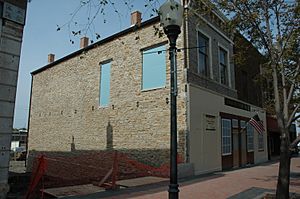Constitution Hall (Topeka, Kansas) facts for kids
Constitution Hall in Topeka, Kansas, is a very important building from early Kansas history. It's a two-story building made of local stone with a flat roof. Two brothers, Loring and John Farnsworth, built it between April and October 1855. Back then, it was right in the middle of the city.
In 1855, people in Kansas Territory were arguing about whether Kansas should allow slavery. People who didn't want slavery were called "free-state settlers." On October 23, 1855, these free-state settlers met at Constitution Hall. They held a big meeting called the Topeka Constitutional Convention.
Almost 40 leaders who were against slavery attended this meeting. At the time, a group that supported slavery had taken control of the territory's government through unfair elections. So, the free-state settlers decided to create their own government. This new government didn't have official legal power, but it showed their strong beliefs.
The convention created a plan for Kansas to become a state without slavery. This plan was called the Topeka Constitution. In July 1856, the United States House of Representatives voted for Kansas to join the country as a free state. However, the United States Senate had more members who supported slavery, and the plan failed by just two votes. Later, some ideas from the Topeka Constitution were used in the Wyandotte Constitution, which became the official Constitution of Kansas in 1859.
Constitution Hall became the main meeting place for the free-state government and its lawmakers. This made the pro-slavery leaders in Congress very angry. They asked President Franklin Pierce to send soldiers to stop the free-state government. In July 1856, federal troops, led by Colonel Edwin Vose Sumner, arrived at Constitution Hall. It was July 4th, and the lawmakers faced soldiers with rifles, bayonets, and even a cannon. They had no choice but to leave.
Even after this, the free-state government continued to meet at Constitution Hall. Sometimes, they even stored supplies taken from pro-slavery towns in the building's basement. By the early 1860s, other buildings were built next to Constitution Hall. This made it part of a long row of connected buildings. When Kansas officially became a state in 1861, Topeka was chosen as its capital city.
Kansas State Capitol: 1863-1869
The new Kansas government planned to build a big, permanent state capitol building. While they waited for it to be built, they needed a temporary place to work. In 1863, they remodeled Constitution Hall and some of the buildings next to it. This group of buildings became known as "State Row." Old photos from the Kansas Historical Society show State Row clearly.
State Row served as the Kansas capitol for several years. During this time, the first part of the current State Capitol building was being constructed. When the east wing of the new capitol was finished in 1869, the state offices moved into the new space.
Constitution Hall's Later Life: 1869-2006
After the state offices moved out on December 25, 1869, Constitution Hall and the other buildings in State Row were used for many different things. They housed shops selling weapons, used books, and jewelry. There were also pharmacies, furniture stores, restaurants, offices, and even apartments. Over the next 100 years, the buildings were changed a lot. This made it hard to tell which parts were the original Constitution Hall.
On July 4, 1903, a local group called the Daughters of the American Revolution (DAR) placed a special marker in the sidewalk. It showed where Constitution Hall was located. But over time, people walking on it wore down the words. So, the DAR decided to move the marker onto the building itself. They put it on the Topeka Cutlery Shop, at 429 South Kansas Avenue. However, some people weren't sure if that was the exact spot of the original Constitution Hall.
By the mid-1980s, the area around the cutlery shop started to become empty. The shop closed in 1986. Other businesses came and went, but no one stayed at 429 South Kansas Avenue. By 1990, many buildings on that street block were torn down. The old cutlery shop was also in very bad condition.
In the early 1990s, local historians and people who wanted to save old buildings tried to fix up State Row. But there was a disagreement. Some thought the buildings had been changed so much that nothing original was left. Because of this, the plan to save the buildings didn't work out.
Official Recognition and Preservation
Later, after more research, experts finally confirmed that 427 and 429 South Kansas Avenue were indeed Constitution Hall. People who wanted to save the building formed a group called "Friends of the Free State Capitol Inc." They worked hard to make sure the building would survive. In 2001, the National Park Service added the building to the National Underground Railroad Network to Freedom. This network highlights places important to the history of freedom.
In October 2002, the National Park Service gave a grant to the Friends group to help with planning. The City of Topeka also gave them money to fix Constitution Hall's roof. In 2006, the Friends group helped create a large mural. This mural covers the front of some State Row buildings. It celebrates Constitution Hall and the time the unofficial legislature was forced to leave in 1856. Finally, on July 15, 2008, Constitution Hall was officially added to the National Register of Historic Places. This is a list of important historical sites in the United States.
Some visitors have said they felt strange things inside Constitution Hall, as if it might be haunted. A group that studies unexplained events planned to investigate in October 2008, but they didn't share any findings.
Work to restore Constitution Hall began in 2011. These efforts will continue as more money becomes available to help preserve this important piece of Kansas history.



